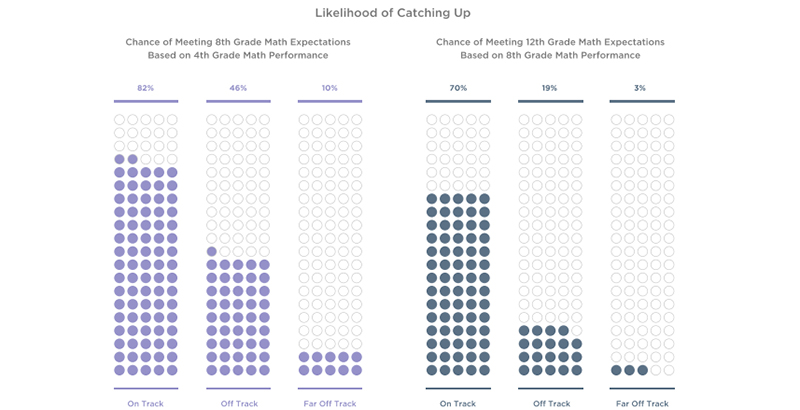Complete report
 New Classrooms Innovation Partners
New Classrooms Innovation Partners
Walk into almost any classroom in
America, and you’ll find at least some students who’ve fallen behind the
academic standards for their grade — meaning they’re at risk of not
learning everything they’ll need to be ready for college and the lives
they want to lead. Helping these students get back on the path to
grade-level proficiency is one of the most urgent challenges teachers
face every day.
But as our organizations revealed in separate reports over the past year, it’s a challenge few schools and school systems have a real strategy to meet. By examining the quality and rigor of the work students are asked to do in class each day, our reports reached two conclusions — contradictory, at first glance — about the ways schools let struggling students down.
TNTP’s 2018 report The Opportunity Myth found that when students don’t meet grade-level standards, the problem usually isn’t that they tried and failed but that they were never given a real chance to try in the first place. The 4,000 students TNTP studied across five school systems spent hundreds of hours each year on work that was below their grade level. Those who started the year behind academically were the least likely to have grade-appropriate assignments — even when they were capable of succeeding on them — making it nearly impossible for them to ever catch up to their peers.
Then, this fall, New Classrooms Innovation Partners released The Iceberg Problem: How Assessment and Accountability Policies Cause Learning Gaps in Math to Persist Below the Surface … and What to Do About It, making a seemingly divergent argument. The paper highlights how an exclusive focus on grade-level material can hinder students’ progress in math, especially when they have unfinished learning from prior years. Instead, learning gaps accumulate and students graduate unable to access some of the fastest-growing and highest-paying jobs in the country because they lack advanced mathematical skills.
So which is it? Are kids being held back because of a lack of access to grade-level material, or because of an exclusive focus on grade-level material?
It’s both.
But as our organizations revealed in separate reports over the past year, it’s a challenge few schools and school systems have a real strategy to meet. By examining the quality and rigor of the work students are asked to do in class each day, our reports reached two conclusions — contradictory, at first glance — about the ways schools let struggling students down.
TNTP’s 2018 report The Opportunity Myth found that when students don’t meet grade-level standards, the problem usually isn’t that they tried and failed but that they were never given a real chance to try in the first place. The 4,000 students TNTP studied across five school systems spent hundreds of hours each year on work that was below their grade level. Those who started the year behind academically were the least likely to have grade-appropriate assignments — even when they were capable of succeeding on them — making it nearly impossible for them to ever catch up to their peers.
Then, this fall, New Classrooms Innovation Partners released The Iceberg Problem: How Assessment and Accountability Policies Cause Learning Gaps in Math to Persist Below the Surface … and What to Do About It, making a seemingly divergent argument. The paper highlights how an exclusive focus on grade-level material can hinder students’ progress in math, especially when they have unfinished learning from prior years. Instead, learning gaps accumulate and students graduate unable to access some of the fastest-growing and highest-paying jobs in the country because they lack advanced mathematical skills.
So which is it? Are kids being held back because of a lack of access to grade-level material, or because of an exclusive focus on grade-level material?
It’s both.
No comments:
Post a Comment